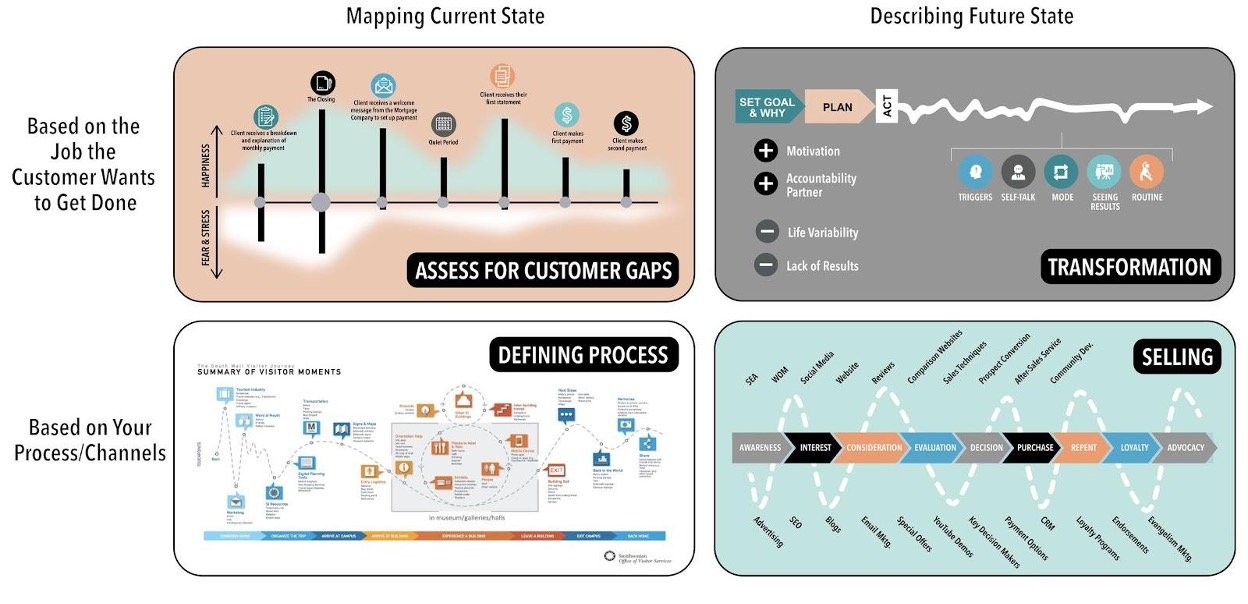Drive Increased Patient-Centricity with Better Journey Maps
Do you work for a life sciences company that is trying to drive greater patient centricity? The journey map can be a powerful tool in this effort if the maps are created and utilized correctly. However, there are a few endemic challenges that tend to get in the way. From organizational silos that fragment the patient experience to a historical orientation towards market-driven - versus experience-driven- strategy, companies are missing out on the great potential of journey maps to create exceptional patient experiences. If you're wondering how these journey maps can work their magic in healthcare, or if you're already using them but not quite sure if you're doing it right, we can help.
What a Journey Map is
While the modern journey map’s roots are in software user experience, they have evolved to be a strategic guide that helps companies zero in on customers' needs when making decisions about how to engage and support them. Literally, a journey map is a visual representation or diagram that illustrates the steps, experiences, and touchpoints that a person goes through when interacting with a product, service, or organization. It documents the multiple facets of a customer’s experience within that interaction. Most journey maps show a linear progression of phases or stages that customers move through and the level of focus can be as tight as their interactions solely with your product or as broadly as their overall life system. The most important element is the core customer need(s) - also referred to as their “job to be done” - but the map should also include emotions, touchpoints, mindset, modes, tools, environments, barriers, goals, triggers and behaviors at various stages of their journey. Future-oriented journey maps include not just current pain points, but how to make customer interactions smart and meaningful.
Journey maps can be used across the organization from leadership, marketing, sales, operations, business strategy, channel strategy, analytics and measurement, or as a guide for implementing third-party technology solutions.
Why Journey Maps are so Important
The goal of any experience strategy is to drive value through customers’ experience with a company. The better the experience meets patient needs and helps them do the jobs they need to get done, the more successful the business will be. Journey maps are the navigational tool that helps you accomplish this. They provide a high-level overview that can guide mission, vision, and value proposition activities. They can inform strategic plans. And, they can also provide details for improving patient marketing, HCP outreach, patient support, patient advocacy, and future product innovations. The journey mapping process can - and should - start as early as the drug discovery phase and inform every step forward in the product development cycle to continually ensure that the patients’ needs are driving decision-making.
However, the benefits of patient journey mapping extend well beyond the product development cycle. A truly patient-centric organization is structured to create and deliver a cohesive patient experience. Many current life sciences companies still have siloed structures that fragment the experience. Using the enterprise-level patient journey maps as a tool to evaluate how a company’s organizational structure is supporting or hindering this patient experience can be profoundly insightful to guide organizational changes that will have enormous benefits for the patients as well as the company’s bottom line.
Building More Effective Journey Maps
There are a few key barriers in the life sciences space to creating effective journey maps:
Organizational siloing diminishing a shared understanding of the customer - As noted earlier, in most organizations, patient experience is often divided across various departments - marketing, patient advocacy, patient support, etc. - and the journey maps that each department creates tend to focus on just one portion of the patient experience and contributes to the delivery of a fragmented patient experience. While each of these functions might need a slightly different core view for their journey maps, there are many common baseline elements that are created separately in each department, resulting in wasted effort or even conflicting journey maps. Ultimately, this results in a fragmented, sub-optimal customer experience.
Lack of alignment on purpose and framework for the journey map - The terms “journey mapping” and “process mapping” are often used interchangeably within organizations, which can result in misunderstanding about the goal and impact of a journey map that is being developed.
Using market research instead of experience research to inform the journey map - Identifying the customer needs (“jobs to be done”) to inform the journey map is best done through experience research, which is fundamentally different from traditional market research. Applying traditional market research outputs to a journeymap will result in an incomplete, or potentially inaccurate view, of the customer needs. This is largely because market research tends to be limited to the person’s experience with the product or service versus experience research, which views it in the larger context of their life system. In healthcare, experience research examines the user's holistic health experience as context for their experience with your product or service.
How to make Journey Maps more Effective
Align journey mapping efforts across the various departments supporting the patient experience - If the patient journey is segmented across departments, a key first step is bringing those departments together to develop the map as a joint effort. Evaluating research done to date and cross-departmental knowledge of the patient experience will maximize the realization of the value of money already spent on journey map creation and ensure that future funds will be well spent. This doesn’t require a corporate reorg - just the commitment of the people supporting the journey mapping effort to align on approach, maximize work done to date, reconcile conflicting information, and develop a collaborative plan going forward. Need support? We help clients regularly with this!
For new or updated journey mapping, a key step is ensuring that the department(s) that need to use it is aligned on the purpose of the journey map, as this is critical in creating a map that captures the right information in the correct context. It will properly inform the experience research done to create the journey map (asking the right questions), the information contained in the map, and the format of the map itself.
Almost all journey maps can be categorized into one of four types. And you can determine the type of map you are developing based on two questions:
Will the journey map be based on the ‘job’ that the customer wants to get done or your processes/channels?
Will the journey map be a map of the customers’ experience with your solution in its current state, or will you be describing the future state of a customer experience?
The following framework outlines the four types of journey maps based on the answers to the above questions:
Defining Process
If you are mapping your current state and the journey is principally focused on your processes and requirements, then the purpose of your journey mapping is to define your process.Assess for Customer Gaps
If your journey map is focused on how the customer gets their ‘job’ done and you are mapping their experience with your current offering, then you are using your journey map to assess gaps or pain points in the current experience.Guide Transformation
If you are using insights from customers to align your future offering with the job(s) your customers want to get done, then you are journey mapping to guide business transformation. This type of mapping will help lead your organization to innovate across different silos in a way that teams can understand.Selling
If you are mapping a future state and the journey is principally focused on your process or channels, then the purpose of your journey mapping is to guide your thinking about selling or convincing the customer of your merits.
3. Use the right experience research approach - Once you have evaluated work done to date, and ensured you have aligned on purpose, you can develop a research plan that asks the right questions of the right patients to identify their jobs to be done and utilize the findings to create a journey map that will be usable across the departments to create a more cohesive patient experience. Overlaying a behavioral lens onto the journey map can supercharge the information contained within as it will help you identify where and how to drive behavior change in your target audiences to better drive health outcomes.
Next Generation Journey Maps - The Experience Map
The pandemic fundamentally changed consumer expectations about experiences with the companies they interact with across the board, from retail to healthcare. Digital-first, self-service, and seamless omnichannel interactions are now baseline requirements, not nice-to-haves. These expectations will continue to evolve to incorporate AI to more efficiently deliver on these requirements, better integrate data to inform experiences and mitigate staffing shortages, particularly in healthcare.
With these changes, we think it’s time to rethink ‘journey mapping’ and build new tools that address a post-pandemic, global, AI-driven customer world. In this year’s Experience Strategy Collaboratives Program, we will be teaching the “experience map”, a whole new set of techniques and tools that build on what is best and most strategic about journey mapping while ensuring that the map accomplishes its intended purpose: customer-centricity. And we infuse this thinking into all of our project work as well.
Want to learn more? Schedule a call with us!


